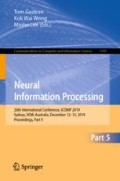Abstract
Effective analysis of remote sensing images remains a challenging topic in deep learning research field. This paper proposes a semantic segmentation approach based on the inception architecture. Specifically, the combination of residual network and Inception improves the feature extraction capability of encoder network. In addition, this paper discusses the problem of unbalanced information allocation caused by concatenated operation in the up-sampling process of network models such as Unet, and the RCSE module is proposed to complete feature reconstruction to solve this problem. The approach ensures accurate assignment of semantic labels to the buildings in the aerial images. Experiments based on the dataset proposed by CrowdAi certify the effectiveness of our approach with a 3.7% IoU improvement compared to Unet.
Access this chapter
Tax calculation will be finalised at checkout
Purchases are for personal use only
References
Badrinarayanan, V., Kendall, A., Cipolla, R.: Segnet: a deep convolutional encoder-decoder architecture for image segmentation. IEEE Trans. Pattern Anal. Mach. Intell. 39, 2481–2495 (2017)
Chollet, F.: Xception: Deep Learning with Depthwise Separable Convolutions. arXiv e-prints, October 2016
Hu, J., Shen, L., Sun, G.: Squeeze-and-excitation networks. CoRR abs/1709.01507 (2017). http://arxiv.org/abs/1709.01507
Huang, G., Liu, Z., van der Maaten, L., Weinberger, K.Q.: Densely connected convolutional networks. In: Proceedings of the IEEE Conference on Computer Vision and Pattern Recognition (2017)
Huang, Z., Cheng, G., Wang, H., Li, H., Shi, L., Pan, C.: Building extraction from multi-source remote sensing images via deep deconvolution neural networks. In: 2016 IEEE International Geoscience and Remote Sensing Symposium (IGARSS), pp. 1835–1838, July 2016. https://doi.org/10.1109/IGARSS.2016.7729471
Marmanis, D., Schindler, K., Wegner, J.D., Galliani, S., Datcu, M., Stilla, U.: Classification With an Edge: Improving Semantic Image Segmentation with Boundary Detection. arXiv e-prints, December 2016
Ronneberger, O., Fischer, P., Brox, T.: U-net: convolutional networks for biomedical image segmentation. In: Navab, N., Hornegger, J., Wells, W.M., Frangi, A.F. (eds.) MICCAI 2015. LNCS, vol. 9351, pp. 234–241. Springer, Cham (2015). https://doi.org/10.1007/978-3-319-24574-4_28
Shelhamer, E., Long, J., Darrell, T.: Fully convolutional networks for semantic segmentation. IEEE Trans. Pattern Anal. Mach. Intell. 39(4), 640–651 (2017). https://doi.org/10.1109/TPAMI.2016.2572683
Szegedy, C., Vanhoucke, V., Ioffe, S., Shlens, J., Wojna, Z.: Rethinking the inception architecture for computer vision. CoRR abs/1512.00567 (2015). http://arxiv.org/abs/1512.00567
Yang, H., Wu, P., Yao, X., Wu, Y., Wang, B., Xu, Y.: Building extraction in very high resolution imagery by dense-attention networks. Remote Sensing 10(11) (2018). https://doi.org/10.3390/rs10111768. http://www.mdpi.com/2072-4292/10/11/1768
Zhao, H., Shi, J., Qi, X., Wang, X., Jia, J.: Pyramid scene parsing network. In: Proceedings of IEEE Conference on Computer Vision and Pattern Recognition (CVPR) (2017)
Acknowledgement
This research was supported by [2018GZ0517] [2019YFS0146] [2019YFS0155] which supported by Sichuan Provincial Science and Technology Department, [2018KF003] Supported by State Key Laboratory of ASIC & System, Science and Technology Planning Project of Guangdong Province [2017B010110007]. Project S201910619048 supported by Sichuan’s Training Program of Innovation and Entrepreneurship for Undergraduate.
Author information
Authors and Affiliations
Corresponding author
Editor information
Editors and Affiliations
Rights and permissions
Copyright information
© 2019 Springer Nature Switzerland AG
About this paper
Cite this paper
Xu, K. et al. (2019). IRSNET: An Inception-Resnet Feature Reconstruction Model for Building Segmentation. In: Gedeon, T., Wong, K., Lee, M. (eds) Neural Information Processing. ICONIP 2019. Communications in Computer and Information Science, vol 1143. Springer, Cham. https://doi.org/10.1007/978-3-030-36802-9_5
Download citation
DOI: https://doi.org/10.1007/978-3-030-36802-9_5
Published:
Publisher Name: Springer, Cham
Print ISBN: 978-3-030-36801-2
Online ISBN: 978-3-030-36802-9
eBook Packages: Computer ScienceComputer Science (R0)

